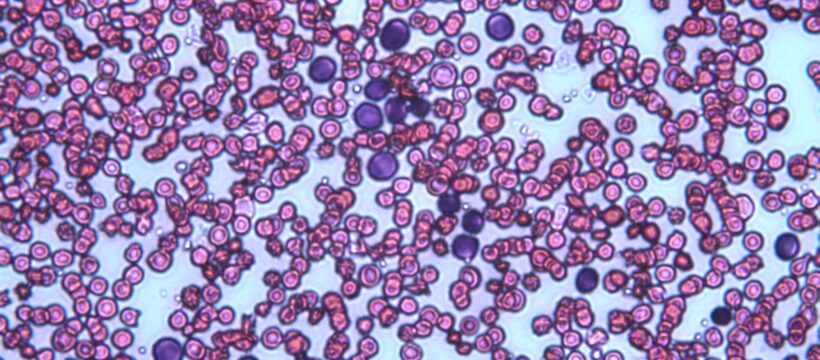Study by Karl Landsteiner University of Health Sciences shows effect of STAT3β on interferon activity. Optimised prognosis of disease progression possible.
Krems (Austria), 04. June 2024: The protein STAT3β has a positive influence on the course of acute myeloid leukaemia (AML) and could serve as a prognostic marker in the future. These are the outstanding results of a cancer research study at the Karl Landsteiner University of Health Sciences (KL Krems). In the work now published in Cell Death & Disease, an international research team succeeded in identifying the previously unknown effect of the protein on interferon-dependent signalling pathways. The results of the study suggest that knowledge of the amount of STAT3β could help to make novel personalized treatment choices for AML.
Acute myeloid leukaemia (AML) is a malignant disease of the haematopoietic system in which a wide range of different cellular and genetic alterations can be observed. This complexity poses an enormous challenge to the development of effective therapies. One protein that is now receiving particular attention is STAT3 (Signal Transducer and Activator of Transcription 3). It exists in two forms (α and β), with the α form tending to promote tumours and the β form rather suppressing them. An international research team from Austria, Hungary, and Italy, coordinated by KL Krems, has focused on the β form (STAT3β) and intensively investigated its tumour-suppressing role in AML – with promising results.
Better with more STAT3β
“We were able to show that STAT3β has a positive influence on the course of AML,” says Prof. Dagmar Stoiber-Sakaguchi, Head of the Division of Pharmacology at KL Krems and head of the research team, succinctly summarising its key findings. Crucial to this discovery was the establishment of an animal model in which the expression of STAT3β in the leukaemia cells was inhibited. This showed that the absence of the protein significantly shortened the survival time after the onset of AML – a clear indication of a protective effect of STAT3β or its function as a so-called tumour suppressor.
Further results of the study then indicated an interaction of STAT3β with interferon-dependent signalling pathways in the leukaemia cells. Sophie Edtmayer, PhD student and first author of the study, commented: “We were able to show by RNA sequencing analyses that the loss of STAT3β leads to an increase in interferon-dependent signals in the cells. This observation was also confirmed by a higher sensitivity of these cells to inhibitors of the interferon signalling pathways.”
Practical application
„We then wanted to investigate the specific significance of our results for patients,” Prof Stoiber-Sakaguchi explains the further course of the study. To this end, the Medical University of Graz provided leukemic cells from affected patients. These were used to analyse whether there is a correlation between the amount of STAT3β and the expression of interferon-activated genes as well as the survival time of those affected.
The results of this study were compelling, showing that lower levels of STAT3β were associated not only with increased expression of interferon-activated genes, but also with reduced survival. Prof Stoiber-Sakaguchi comments: “This finding suggests that STAT3β levels could be used to predict disease progression.” In fact, the team is already thinking ahead: the discovery of a link between low STAT3β, activation of interferon-dependent pathways and reduced survival suggests that therapeutic intervention in the interferon pathways could have a positive effect on the course of AML – a promising result of this study coordinated by KL Krems and published in a renowned scientific journal.
Original publication: A novel function of STAT3β in suppressing interferon response improves outcome in acute myeloid leukemia. S. Edtmayer, A. Witalisz-Siepracka, B. Zdársky, K. Heindl, S. Weiss, T. Eder, S. Dutta, U. Graichen, S. Klee, O. Sharif, R. Wieser, B. Győrffy, V. Poli, E. Casanova, H. Sill, F. Grebien & D. Stoiber. Cell Death Dis., 2024 May 28;15(5):369. doi: 10.1038/s41419-024-06749-9.
Link to publication: https://kris.kl.ac.at/en/publications/a-novel-function-of-stat3β-in-suppressing-interferon-response-imp
Karl Landsteiner University of Health Sciences (06/2024)
The Karl Landsteiner University of Health Sciences (KL Krems) is an educational and research institution on the Campus Krems and recognised throughout Europe. KL Krems offers modern, demand-oriented education and continuing education in medicine and psychology as well as a PhD programme in Mental Health and Neuroscience. The flexible educational programme is tailored to the needs of students, the requirements of the labour market and the challenges of science. The three university hospitals in Krems, St. Pölten and Tulln and the MedAustron Ion Therapy and Research Centre in Wiener Neustadt guarantee clinical teaching and research of the highest quality. In its research, KL Krems focuses on interdisciplinary fields with high relevance to health policy – including biomechanics, molecular oncology, mental health and neuroscience as well as the topic of water quality and the associated health aspects. KL Krems was founded in 2013 and accredited by the Austrian Agency for Quality Assurance and Accreditation (AQ Austria). https://www.kl.ac.at/en
Scientific Contact
Prof. Dr. Dagmar Stoiber-Sakaguchi
Division of Pharmacology
Karl Landsteiner University of Health Sciences
Dr.-Karl-Dorrek-Straße 30
3500 Krems / Austria
T +43 2732 72090 470
Karl Landsteiner University of Health Sciences
Eva-Maria Gruber
Communications, PR & Marketing
Dr.-Karl-Dorrek-Straße 30
3500 Krems / Austria
T +43 2732 72090 231
M +43 664 5056211
Copy Editing & Distribution
PR&D – Public Relations for Research & Education
Dr. Barbara Bauder
Kollersteig 68
3400 Klosterneuburg / Austria
M +43 664 1576 350
L https://www.linkedin.com/company/prd-public-relations-für-forschung-bildung

